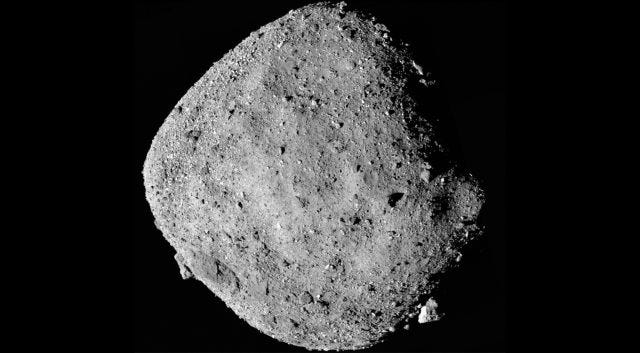Exploring Bennu: NASA's Journey to Sample an Asteroid's Secrets
Written on
Chapter 1: Introduction to OSIRIS-REx
NASA's OSIRIS-REx spacecraft has been orbiting the asteroid Bennu since late 2018, and it is now nearing the pivotal moment of sampling the surface. Over the past few years, researchers have gathered significant information about Bennu, leading to the publication of six detailed studies in the journals Science and Science Advances. These studies illuminate the environment and composition of this intriguing celestial body. It’s anticipated that OSIRIS-REx will capture a variety of materials, which are not just ordinary rocks, but rather exciting geological samples.
One notable study, conducted by Amy Simon at NASA's Goddard Space Flight Center, reveals that carbon-rich minerals are abundantly distributed across Bennu, particularly in the Nightingale landing zone where OSIRIS-REx plans to land. Scientists on Earth are already devising experiments to analyze these materials, which may provide valuable insights into the origins of water and life on our planet.
Section 1.1: Carbonates and Water Evidence
Another research effort specifically examined carbonate minerals, which are salts derived from carbonic acid, visible in vein structures on some boulders. The presence of carbonates indicates that Bennu's parent body once had both water and carbon dioxide, leading researchers to hypothesize that a substantial water system existed, potentially stretching for miles. This widespread occurrence of carbonate minerals has generated excitement among scientists, as they may be included in the samples OSIRIS-REx is set to collect.
Subsection 1.1.1: Mapping the Surface

Prior to sample collection, the mission focused on meticulously mapping Bennu's surface, enabling NASA to analyze the asteroid's topography and select an ideal landing site. The resulting map, with a remarkable resolution of 20 cm per pixel, is the most detailed ever created for an asteroid. The following video offers a captivating tour of Bennu, showcasing a blend of photographs and laser altimeter data.
Section 1.2: The Sampling Process
On October 20th, OSIRIS-REx will make its descent to tap the surface, employing a burst of compressed nitrogen gas to hopefully dislodge regolith into its sample container. Although numerous asteroids enter Earth's atmosphere daily, they are often altered by the intense heat of re-entry. Sampling Bennu allows scientists to study pristine material from the early solar system. Recent findings indicate that the area around Nightingale is even more suitable for this purpose than previously thought. The “spectrally red” appearance of the Nightingale site suggests that the materials are recently exposed and thus exceptionally untainted.
Chapter 2: Anticipating the Return
Samples collected by OSIRIS-REx are expected to arrive back on Earth in September 2023. Until that moment, we can only support the probe from millions of miles away.
The first video, titled "NASA: Asteroid samples contain building blocks of life," discusses how the samples from Bennu may reveal critical insights into the origins of life.
The second video, "Looking for the Building Blocks of Life in Asteroid Samples," delves into the scientific investigations aimed at understanding the building blocks of life through the asteroid samples.
Now read: We Might Be Able to Stop Killer Asteroids By Tethering Them Together; Astronomers Give Asteroid Moon a New Name Before NASA Hits It With a Spacecraft; NASA’s Asteroid Mission Completes Final Test Before Sampling Run.